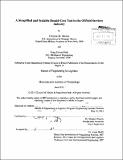A simplified and scalable should-cost tool in the oilfield services industry
Author(s)
Mealer, Clayton M; Park, Sung Hwan
DownloadFull printable version (6.792Mb)
Other Contributors
Massachusetts Institute of Technology. Engineering Systems Division.
Advisor
Shardul Phadnis.
Terms of use
Metadata
Show full item recordAbstract
Third party spend accounts for a significant amount of a business' costs. When procuring unique, highly-engineered components, this cost is often negotiated with suppliers during the procurement process. Due to the limited understanding of the suppliers' true production cost, various techniques and models for determining how much a procured product should cost have been tried. One such approach is known as "should-cost modeling," where estimates for the cost of a product or service are made based on product architecture and/or firm financials. Both these approaches to should-cost modeling require extensive data collection and are time consuming. In this thesis, we expand an approach that uses aggregate industry-specific financial data to develop a simple, scalable tool to estimate a product's should-cost. One major challenge in building this tool is unifying the simple aggregate data available into an estimated price for a complex product. This is a major challenge of developing a should-cost estimate using existing methods. We develop an approach to simplifying a complex product, construct our model, and create a ready-to-use tool. We demonstrate the working of the model and the tool using the case of a semi-complex product (the fluid end of a pump) representative of a company's procured products. We then compare the price estimated by our model with that currently negotiated with our sponsor company's supplier and solicit qualitative feedback from procurement professionals regarding the should-cost tool's accuracy. The price estimated by our tool is within 9% of the actual negotiated price and required significantly less time to compute compared to the current approach based on product architecture. The company's sourcing and procurement executive strongly endorses the benefits of our approach. This tool can remove the reliance on supplier-supplied quotes and strengthen the purchasing company's negotiating position. The tool developed in this thesis is shown to provide a more accurate estimate of product cost, with significantly less estimation effort.
Description
Thesis (M. Eng. in Logistics)--Massachusetts Institute of Technology, Engineering Systems Division, 2013. Cataloged from PDF version of thesis. Includes bibliographical references (p. 55-57).
Date issued
2013Department
Massachusetts Institute of Technology. Engineering Systems DivisionPublisher
Massachusetts Institute of Technology
Keywords
Engineering Systems Division.